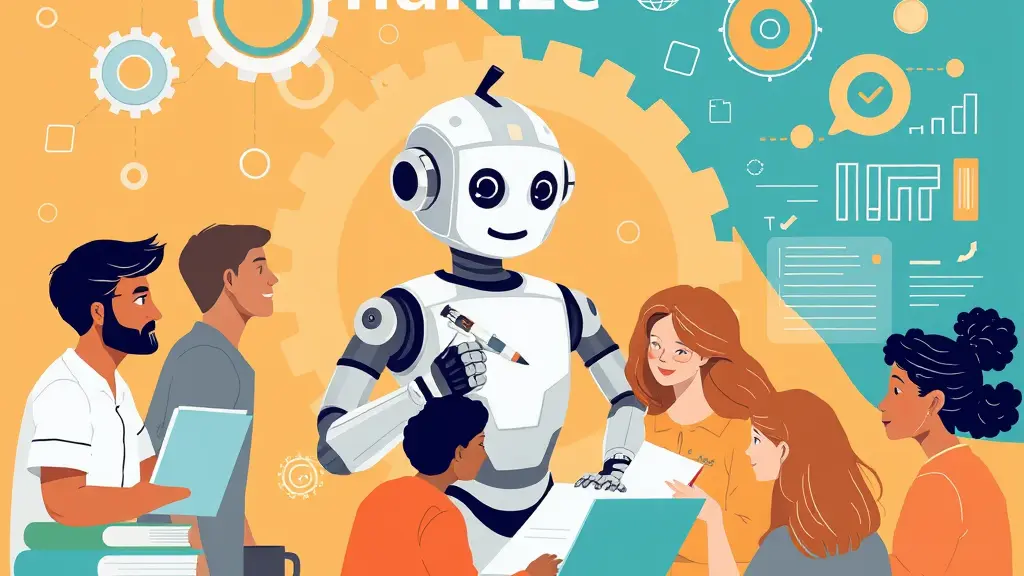Artificial Intelligence (AI) is changing the way we live, work, and communicate. From voice assistants like Siri and Alexa to smart recommendations on Netflix or Amazon, AI is everywhere. But as machines become smarter, there’s a growing concern: how do we make AI feel more human? This is where the concept of “humanize ai” comes in. In simple terms, it means making AI more relatable, understandable, and emotionally aware—so that people feel comfortable and connected when interacting with it.
In this article, we will explore what it means to humanize AI, why it matters, and how it can be achieved.

What Does It Mean to Humanize AI?
To “humanize AI” means designing artificial intelligence systems that behave and interact in a way that feels more human-like. It’s not about pretending AI is human but about making it more natural, ethical, and emotionally intelligent.
Here are some basic goals of humanizing AI:
- Understand human emotions and respond appropriately
- Use natural language that feels friendly and conversational
- Show empathy and sensitivity in interactions
- Provide helpful, respectful, and ethical behavior
- Real-Life Examples
- Chatbots in customer service: Instead of robotic replies, humanized AI can offer warm greetings, understand frustration, and solve problems in a friendly tone.
- Healthcare assistants: AI systems like virtual nurses or mental health apps can provide support while sounding empathetic and calming.
- Enhancing Employee Experience with AI: The movement toward more human-centric technology is reshaping how organizations engage with their teams. Solutions like AI HR software enable HR leaders to offer more responsive, empathetic, and tailored interactions throughout the employee lifecycle.
Why Do We Need to Humanize AI?
AI is becoming part of our daily lives. However, many people feel uncomfortable talking to a machine that sounds too cold or mechanical. Humanizing AI helps solve this issue.
1. Improves User Trust and Comfort
When AI responds in a way that feels human, users trust it more. Trust is essential, especially in areas like healthcare, education, or financial services.
2. Makes Communication Easier
People naturally respond better to human-like communication. If AI can talk, listen, and understand like a human, the experience becomes smoother and more enjoyable.
3. Supports Mental and Emotional Needs
AI that understands emotions can provide better mental health support. For example, AI used in therapy apps can respond with kindness and care, which is important for users going through tough times.
4. Encourages Ethical Use of AI
Humanizing AI also includes adding values like empathy, fairness, and respect. This can help ensure that AI doesn’t reinforce bias, discrimination, or unethical behavior.

Key Elements to Humanize AI
To make AI more human-like, developers and designers focus on certain features:
1. Natural Language Processing (NLP)
This allows AI to understand and respond in natural human language. Advanced NLP helps AI pick up on tone, slang, grammar, and even sarcasm.
2. Emotional Intelligence
Emotion AI (also known as Affective Computing) is about teaching AI to recognize human emotions through facial expressions, voice tones, or word choice—and respond appropriately.
3. Personalization
AI can become more human-like when it adapts to each individual. This includes remembering user preferences, speaking styles, and interaction history.
4. Tone of Voice and Visual Design
Even small details like the tone of voice or the AI’s visual appearance (like a digital avatar) can make a big difference. A friendly tone or a warm face makes the AI feel more human.
How Can We Humanize AI Successfully?
Humanizing AI is not just about technical skills. It also requires understanding psychology, ethics, and user behavior. Here are some key practices:
1. Design for Empathy
When creating AI, developers should think about how it makes users feel. Does it sound cold or caring? Is it helpful or frustrating?
For example, if someone asks a mental health chatbot for help, the AI should respond with warmth and encouragement, not just facts.
2. Diverse and Inclusive Data
AI learns from data. If the data is biased or incomplete, the AI will behave unfairly. Using diverse, inclusive data helps the AI understand different cultures, languages, and emotional expressions.
3. Continuous Learning and Feedback
AI should be trained not only once, but continuously. Developers must allow users to give feedback so that the AI can improve over time and stay aligned with human needs.
4. Limit Over-Humanization
It’s important to humanize AI just enough. If AI tries too hard to be human, it can create discomfort or confusion. This is known as the “uncanny valley” effect—when something looks or sounds almost human but feels strange or creepy.
Challenges of Humanizing AI
Humanizing AI is powerful, but it comes with challenges:
1. Ethical Dilemmas
If AI becomes too human-like, people may forget they are interacting with a machine. This raises questions about manipulation, privacy, and consent.
2. Misuse or Deception
There is a risk that companies or developers may use humanized AI to deceive users or gather data unethically.
3. Emotional Dependence
Some people may become emotionally attached to human-like AI, especially in roles like digital companions. This can affect real-world relationships or mental health.

The Future of Humanized AI
As technology continues to evolve, humanized AI will become even more advanced. In the near future, we can expect:
- AI that understands deeper emotions like stress, boredom, or happiness
- Virtual assistants that can hold natural, flowing conversations for longer
- AI companions for elderly or lonely individuals that provide social support
- Personalized AI tutors that adapt to students’ emotional and learning needs
But with these advancements, we must also build rules and ethics to ensure AI supports humans—not replaces or manipulates them.
Final Thoughts
The journey to humanize AI is not about turning machines into humans, but about designing AI that serves people in a respectful, relatable, and emotionally aware way. It’s about building technology that feels like a partner, not a tool.
By focusing on empathy, personalization, fairness, and ethical behavior, we can create AI systems that not only make life easier—but also more human.
Let’s shape a future where technology understands us, supports us, and grows with us—just like a true companion.
For more interesting articles check out our website.
- Top 5 Best AI Presentation Makers in 2026 - December 24, 2025
- Best AI Text Generator Plugin for Woocommerce: WriteText.ai - December 23, 2025
- The 5 Best AI Tools for PowerPoint Presentations in 2025 - December 22, 2025


